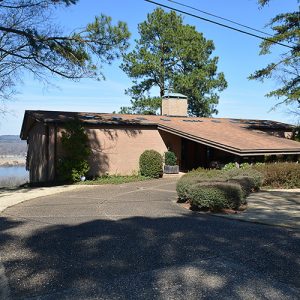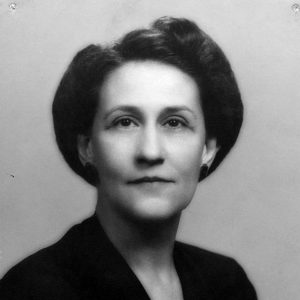calsfoundation@cals.org
Noland Blass Jr. (1920–1998)
Noland Blass Jr., an architect with the firm Erhart, Eichenbaum, Rauch, and Blass (EERB), worked at the firm during its heyday in the mid-twentieth century. Blass began working for the firm in 1946, brought in to help modernize the firm. During Blass’s time there, EERB became one of the most prominent architecture firms in Little Rock (Pulaski County). Blass was also known as one of the most prolific designers of Mid-Century Modern–style residential architecture in Little Rock. His obituary in the Arkansas Democrat-Gazette noted that Blass was “one of Arkansas’ most respected architects,” and was also a “mentor to most of the fine architects in the city.”
Noland Blass Jr. was born in Little Rock on May 28, 1920, to Noland Blass Sr. and Isabel Blass. His grandfather, Gus Blass, established the Gus Blass Company, which developed the largest and most successful department store at the time in the state. His father worked for Blass Department Store, serving as president from 1939 until 1950. Blass knew from the age of twelve that he wanted to be an architect, and after graduating from high school in Little Rock, he attended Cornell University in Ithaca, New York, where he earned his bachelor’s degree in architecture in 1941. While studying at Cornell, Blass received a gold medal award for his senior thesis. After he graduated from Cornell, he volunteered for the U.S. Army, and during World War II he served in Germany and the Philippines as a major with the U.S. Army Corps of Engineers before being discharged in 1946.
Blass began his architecture career when he returned to Little Rock in 1946, starting out as a draftsman with the firm of Erhart, Eichenbaum, and Rauch. The firm of Erhart and Eichenbaum was founded in 1930 by Frank Erhart and Howard Eichenbaum, who, like Blass, were natives of Arkansas who had degrees from architecture schools outside the state. Blass would remain with the firm for his entire professional career, eventually becoming principal designing architect. Although the firm had completed limited work on Moderne-style architecture before Blass was hired, it was Blass’s influence that caused the firm to look more toward Mid-Century Modern as a design inspiration.
Blass married Elizabeth Weitzenhoffer in October 1947, only three months after they had met when she was visiting Little Rock. Her visit had been a suggestion of Blass’s mother after she had seen Weitzenhoffer’s photograph at a friend’s house in Memphis, Tennessee. The couple had two daughters.
In 1955, Blass became a partner in his firm, and the name was changed to Erhart, Eichenbaum, Rauch, and Blass. Over the next several years, Blass worked to expand the focus of the firm to large-scale projects that used many designers, architects, engineers, and even other firms. Since Blass was the principal designer, he left a significant and extensive architectural legacy in the state, including the Worthen Bank Building (which later became the Bank of America), the State Justice Building and Supreme Court Rotunda, Baptist Medical Center, and several projects on the University of Arkansas for Medical Sciences (UAMS) campus. Although he completed many residential designs during his career, they are not as well known, although his own home in Little Rock, the Noland Blass Jr. House, was listed on the National Register of Historic Places on January 24, 2019. Blass retired in the late 1980s, although he continued to design projects for family and friends.
Blass’s long and varied career also brought him many accolades. Blass was a two-term president of the Arkansas Chapter of the American Institute of Architects (AIA) and also served on the University of Arkansas School of Architecture Professional Advisory Board and the advisory council of the Cornell University College of Architecture, Art and Planning. Blass was named a Fellow of the AIA in 1968, and his career of outstanding work was awarded the Gold Medal of the Arkansas Chapter of the AIA in 1989.
After Blass retired, he and his wife spent up to four months a year at an artists’ colony in Mexico. He also studied at the Art Institute in San Miguel de Allende, a popular art school in central Mexico for students from different countries. Blass continued to work on architectural projects and pursue his artistic endeavors until his death on July 21, 1998. Blass is buried at Oakland-Fraternal Cemetery in Little Rock.
For additional information:
“Arkansas Construction Hall of Fame Blass.” Arkansas Business, April 2, 2001, pp. 2–3.
Ault, Larry. “Architect Helped Shape the Look of Central Arkansas for 50 Years.” Arkansas Democrat-Gazette, July 23, 1998, p. 6B.
LeMaster, Carolyn Gray. A Corner of the Tapestry: A History of the Jewish Experience in Arkansas, 1820s-1990s. Fayetteville: University of Arkansas Press, 1994.
Williams, Callie, and Mason Toms. Lecture on the life and work of Noland Blass Jr., May 9, 2017. On file at the Arkansas Museum of Fine Arts, Little Rock, Arkansas.
Ralph S. Wilcox
Arkansas Historic Preservation Program
 Arts, Culture, and Entertainment
Arts, Culture, and Entertainment World War II through the Faubus Era, 1941 through 1967
World War II through the Faubus Era, 1941 through 1967 Alexander House
Alexander House  Isabel Blass
Isabel Blass  Dante House
Dante House 



Comments
No comments on this entry yet.